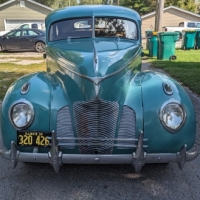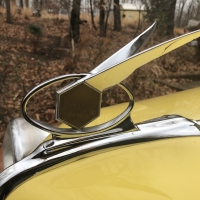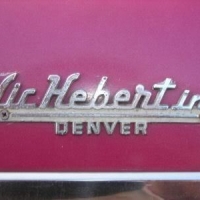Headlight issues...still, advice please
Hello all, so here is what I have, I put a headlight relay in my 39 six. I have no lights. So, I started tracing voltage. I have 6volts at the battery, to the starter 6 volts to the voltage regulator position B (which is what powers my fuse block. at position B on the fuse block where wire from regulator comes in, I have 6 volts. The wire that goes out to head light switch, which is SW position on the fuse block, I have 6 volts going to headlight switch. At head light switch I have 6 volts coming in. I have 5 volts coming out, 5 volts going into the dimmer switch. 5 volts coming out. 5 volts at the switch side of teh relay. O volts on the light side of the relay. Hence no lights. Not sure what to do next. I guess maybe remove relay and clean mounting surface of all paint. Could it be that the relay isn't getting a good ground? Please advise
0
Comments
-
How are you firing the headlight relay? When you say you have 6V at the headlight relay, is that to the relay coil or relay armature?So you should have a direct feed from the floor dimmer switch to the relay coil, the other side of the coil goes to ground. You need a direct -6v feed from your fuse block to the relay armature. The normally closed contact side goes to low beam side and the normally open goes to the high beam.0
-
I have 5 volts at the relay where the wires connect to teh switch side of the relay.0
-
Does the relay click when you switch either high or low beam on? 5 volts should energise the relay. Is there an internal fuse in the relay? The relay should have three terminals on one side (Input) and two on the other (output). Usually the centre terminal on the input side is connected direct to the battery connection on the starter solenoid.0
-
Are you confident it's not a 12v relay?0
-
I can't hear the relay click as I am in the car, but it does not have three terminals on one side. Only two on each. There are two internal fuses. I will check fuses today remove relay and clean so as I have a good ground. Will see what happens. As to it possibly being a 12-volt relay, Maybe but I got it from Doug WIldrick so I seriously doubt it. He knows my car and what I need. I will also post a pic of the relay here.0
-
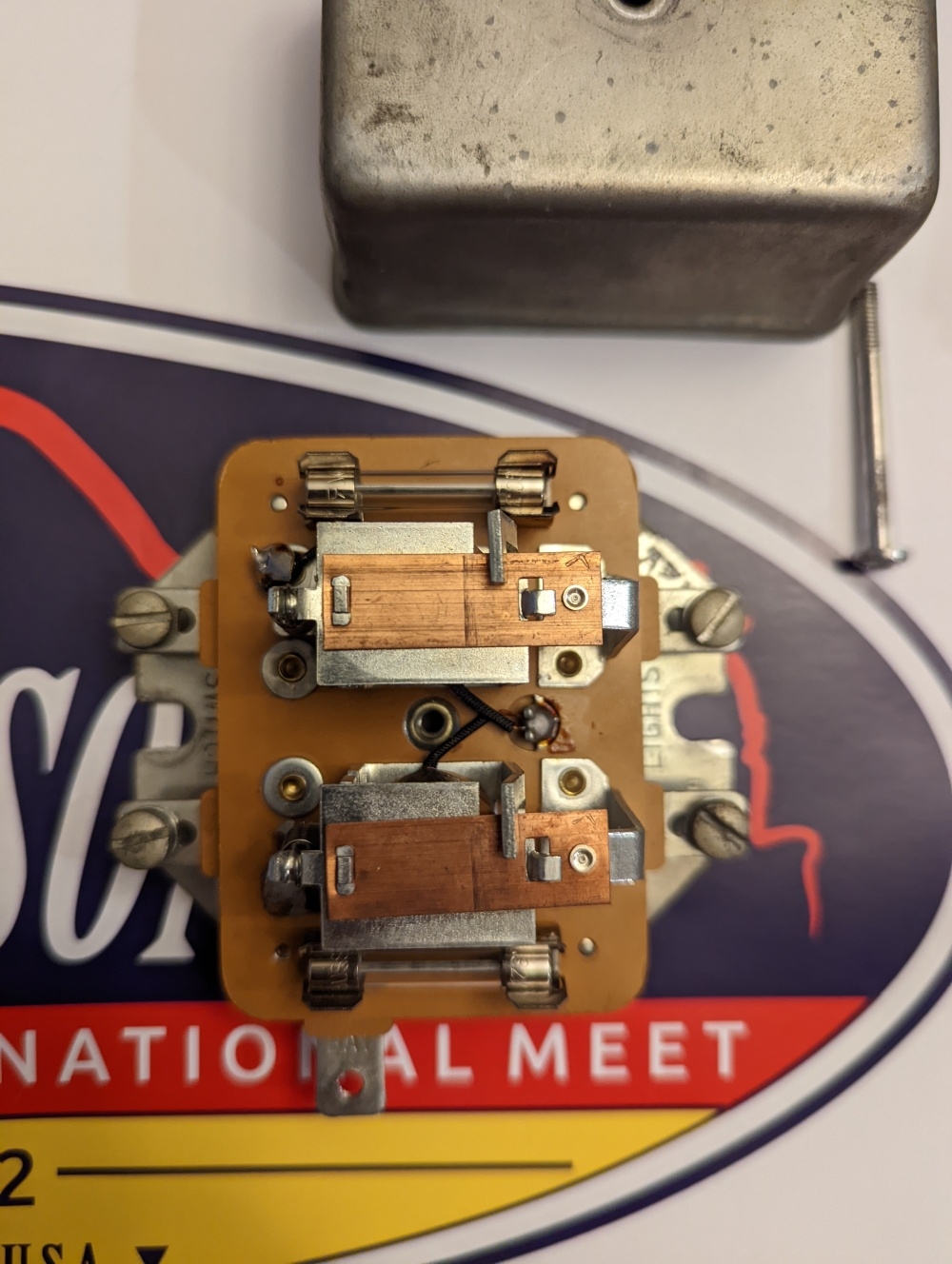 this is my relay
this is my relay
0 -
Okay, so the Battery connection is on the side! What happens if you manually close the relays? The lights should come on.0
-
I will check that Geoff, and let you know I begin to wonder if the relay isn't bad. I will take a wire from power side of battery to the switch side of relay and see if that oulls the coils down. If not, then I have found my problem. If they do pull down Im back to square one.0
-
So where is the "Bat" terminal on the relay connected to?0
-
The starter solenoid on the battery side.0
-
I will manually close relay and check this afternoon when I get in this afternoon0
-
Ok when I manually close the relays the lights come on. But when I take a wire from hot side of battery to switch side of relay nothing and the relays do NOT close. Meaning make contact. Seems like a bad relay0
-
Is it actually stamped with an input voltage? Have you also measured resistance across the coil?0
-
I have not0
-
Another question: is the relay physically mounted to the fender or chassis of your car?0
-
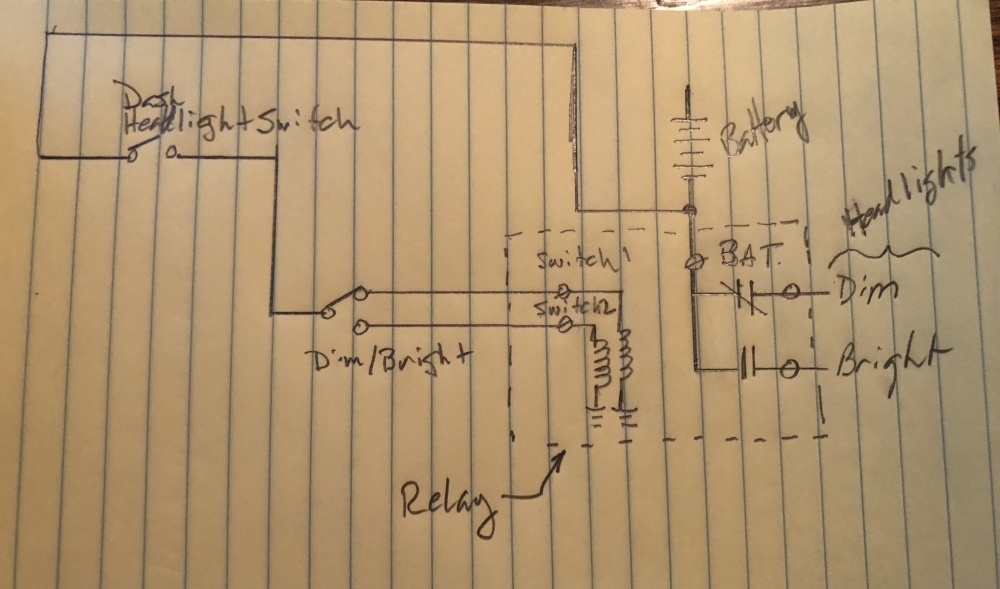 Here’s a quick diagram of the wiring. If your relay is not secured to the fender or firewall, it will not have a path to chassis ground. You can always run a jumper from the relay metal body to the battery positive and apply -6 volts to one of the switch terminals to see if the relay is operating. If not, sounds like a bad relay.0
Here’s a quick diagram of the wiring. If your relay is not secured to the fender or firewall, it will not have a path to chassis ground. You can always run a jumper from the relay metal body to the battery positive and apply -6 volts to one of the switch terminals to see if the relay is operating. If not, sounds like a bad relay.0 -
Tood yes it it is, I removed all paint and cleaned to bare metal, mounted relay to 8nner fender but no dice. 8 have tested and it failed with a direct 6 volts to it. So I will try another relay I have.0
-
And Todd I appreciate the diagram, the relay I have came with one in the box from the manufacturer. I wired it that way. But no dice. I too think bad relay,0
-
Sure sounds that way, Val. So sorry it took the ‘hive’ so long to get this on the path to be sorted out.On another related issue, have you ever taken the dash headlight switch out and cleaned the internal contacts? Typically you would squirt electronic contact cleaner inside to hit the silver-plated switch contacts and then ‘exercise’ the switch repeatedly. Then rinse and repeat. It’s also possible that the switch itself has loosened up, most use brass rivets for construction that can work loose over time. The reason I bring this up is your car was engineered without a headlight relay. Low or no voltage indicates dirty or misaligned contacts on either the dash switch or the dim/bright floor switch. It can also be an indication of bad grounds at your headlights or bad wire connections. The wire gauges used for 6v cars are: 12ga stranded copper for the dash switch feed, dash switch to dim/bright floor switch and out to the fender mounted headlight junction terminal block. From the terminal block to the headlights it’s 14ga stranded copper. I recently rewired my 46 convertible to change it from 12v back to 6v plus replace the rotting cloth covered wire with newly made in the correct colors. There are several vendors that sell it by the footMy observation is that for all of the time spent troubleshooting this relay, you could have rewired the entire circuit per the factory configuration.0
-
Yes, I certainly could have had that done. Fortunately, I don't need to do that as I had a new wire harness installed in 2017. Dr Doug did it for me. I spoke with him at the National about this issue. He said it wasn't a wire issue. But did day it could be a dimmer switch issue. After I install this other relay, I will see what I got. Hopefully good lights. I will keep you posted. And the hive came to my rescue, much appreciated!!!0
-
good deal. Please keep us posted0
-
Ok, I got the other relay cleaned up and the inner fender where it mounts i have cleaned to bare metal. I have headlights!!! But its intermittent. I believe I know the issue. When I hit the dimmer switch it will go to bright. But hit it again and the dim lights don't come back on. I cycle the dimmer switch and they will come back on. So, I feel I have a bad dimmer switch. But I have headlights! Thanks to all who have helped and given advice.0
-
I've heard it said that the grease in NOS dimmer switches hardens up from sitting on the shelf for many years. This makes the mechanism less pliable and -- when you depress the button on the floor -- the mechanism is liable to hang up. If you go out and buy a replacement switch and it's also NOS -- you are likely to encounter the same "hardened grease" problem yet again.
Therefore, you might want to remove your switch, open it, and inspect the insides. This may involve simply unscrewing the switch, or you might have to bend the metal ears that hold the switch together, enough that you can pull the housing apart. (So don't over-bend the ears, or they may break from metal fatigue).
Using some solvent (maybe kerosene or paint thinner), clean out the old grease and then re-lubricate the switch with new grease. You can also clean up the contacts within the switch; they may have corroded. Before you put the switch back in the car, run some simple continuity tests, clicking the switch again and again until you're sure that it works without failing.
Another approach is to buy a modern (12-volt) switch -- so long as the installation screws align with the holes in your Hudson's floor. If (like many people) you have installed a relay in your lighting system, then the amount of amperage going through the dimmer switch would be negligible, since the dimmer would now only be triggering the relays, not running the headlights themselves. Thus the lighter-gauge 12 volt switch wiring is not carrying the heavy load that it would if you had the dimmer hooked directly to the headlight bulbs.
0
Categories
- 36.9K All Categories
- 113 Hudson 1916 - 1929
- 20 Upcoming Events
- 92 Essex Super 6
- 28.6K HUDSON
- 573 "How To" - Skills, mechanical and other wise
- 995 Street Rods
- 151 American Motors
- 178 The Flathead Forum
- 49 Manuals, etc,.
- 78 Hudson 8
- 44 FORUM - Instructions and Tips on using the forum
- 2.8K CLASSIFIEDS
- 608 Vehicles
- 2.2K Parts & Pieces
- 77 Literature & Memorabilia
- Hudson 1916 - 1929 Yahoo Groups Archived Photos
